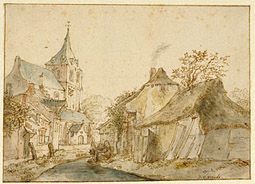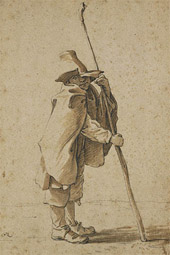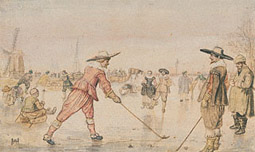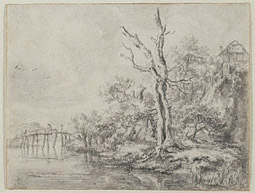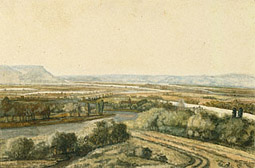|
During the 1600s citizens of the Dutch Republic enjoyed increasing political freedom and economic prosperity, which ushered in a tremendous boom in art production and a flourishing art market. This exhibition of drawings features some of the most beloved genres depicted by Dutch artists during this highly active period. These subjects include the depiction of a tiny native caterpillar, the panoramic landscape, the weathered farmhouse, and a smiling shepherd—a celebration of Dutch life in all of its diversity.
Quotations by artists and critics in the exhibition convey the careful consideration that Dutch draftsmen gave to choosing subjects. Through the practice of drawing, they found new ways to visually render their national pride. Eighteenth-century Dutch artists capitalized on the popular genres established by their predecessors, and continued to draw these subjects in perpetual reference to a golden age. Even as the Dutch Republic began to experience political unrest and declined as a world economic power, artists created drawings that proudly commemorated local architecture, landscapes, and customs.
|
 |
"For cottages, choose the old, curious, broken, and half-fallen peasant houses covered with reeds or straw, with overgrown green plants, with old walls, broken doors and windows, [accompanied by] curious haystacks, dovecotes, plows, wagons, animals or fowl, and decorated with trellised trees."
—Pietersz. Biens, The Art of Drawing, 1636
In the image above by Van Ostade, the dilapidated cottages with peeling plaster walls and thatched roofs appear all the more picturesque by the wagon precariously placed on the sloping riverbank. The bend in the river leads the eye back to the church and the other houses at left.
|
 |
|
"In grassy meadows you will find four-legged animals—take pleasure in drawing them. Peasant woman, milking cows, and singing aloud in the East, West, North, and South.
The cunning hunters and their dogs that spring from the wood, with the wild beasts as their prize."
—P. C. Ketel, "Song of the Landscape Painter," in Karel van Mander's Book of Painters, 1604
Showing a charming shepherd as he peers out from under his floppy hat, this drawing can be associated with Arcadian portraiture of the Dutch Republic that celebrated the harmonious relationship between humankind and nature. Here the belief that the life of the peasant was idyllic and peaceful, devoid of the pressures and worries of the city, is conveyed by the shepherd's sweet smile and contrived pose with his large houlette—a tool typically used to dig small clods of dirt that were then thrown to herd animals in a desired direction.
|
 |
"It is the sweetest pastime, a merry tour,
Speeding hither and with skates upon the ice.
Yet what I desire even more is that the fair maid
Would prefer a tumble elsewhere than on the track."
—I. I. Colevelts, The Amsterdam Pegasus, 1627
Avercamp pioneered the depiction of colorful winter scenes that showed citizens of the Dutch Republic amusing themselves on frozen canals. Here two men play colf, a cross between golf and ice hockey, while others ride in a horse-drawn carriage or glide across the ice on a sled. While enjoying its merry scene, the owner of this highly finished watercolor would have also been reminded of human fallibility by the figures who slip on the ice.
|
 |
|
"Seat yourself in a wood, studious youth, and look around you, observing everything near and far. Notice how the farthest objects are less distinct than those that are near to you; notice too how the foreground comes toward you and how precise the leaves of the nearest trees are compared with the flowers in the distance."
—P. C. Ketel, "Song of the Landscape Painter," in Karel van Mander's Book of Painters, 1604
By focusing on one gnarled, rotting oak tree, Ruisdael brought the wooded landscape to monumental proportions. This sheet was probably made during the artist's trip to Bentheim over the German border. Towering above the living trees and the Germanic, half-timbered house (upper right), the stark, craggy tree is isolated against the sky. To render this tree as a lonely giant rising above everyone and everything, Ruisdael included tiny figures crossing a humble bridge.
|
 |
"Learn first to imitate the riches of nature...the flat fields, the hillocks, the streams, and the forests provide enough work for us....You will find in your homeland so much that is lovely, sweet, and worthwhile, that once you have tasted it, you will judge your life too short to picture it all."
—Samuel van Hoogstraten, Introduction to the Academy of Painting, 1678
Koninck's panoramic landscapes are notable for their suggested vantage point high above the plains. This sweeping panorama does not depict a specific place but is instead a generic representation of a river, a road, fields, and trees from a bird's-eye view. The artist enhanced the sense of a vast horizon by showing the river winding into the distance and portraying remote imaginary mountains. The strongly textured application of colored gouache (opaque watercolor) further abstracts the illustration by creating a uniform, hazy atmosphere.
|
 |
